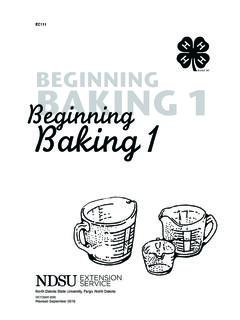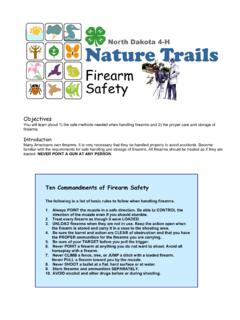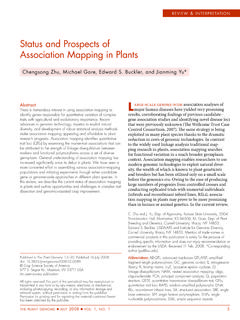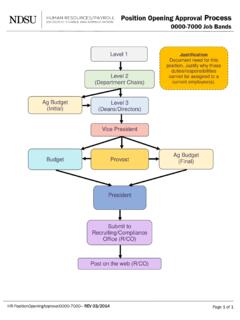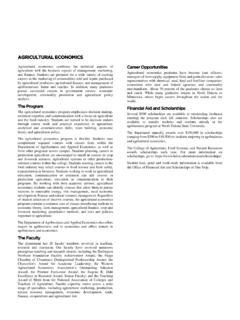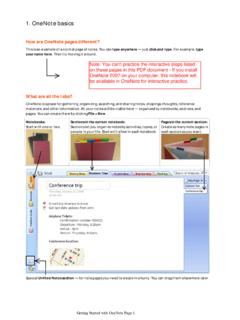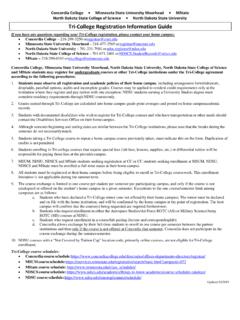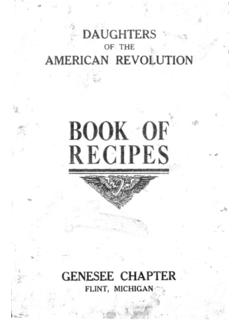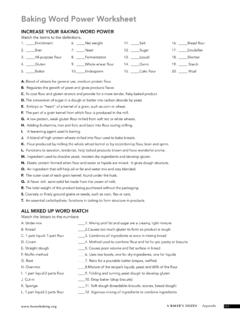Transcription of EC112 BAKING Baking 22 - NDSU
1 EC112 BAKING 2 BAKING 2 north dakota State university , Fargo, north DakotaOCTOBER 2005 Revised September 2016 2 AcknowledgmentsThe New Mexico 4-H Curriculum Review Committee revised this project in of the committee were:Shelly Porter, Colfax County Extension Home EconomistOwida Franz, Union County Extension Home EconomistBetty McCreight, Lincoln County Program Director-Home EconomistMargaret Dines, Grant County Extension Home EconomistDarlene Dickson, 4-H/Youth SpecialistLayout by:Ana Henke, Media Specialist Assistant, Agricultural Communications, New Mexico State UniversityAdapted in north dakota by the 4-H Healthy Livestyles Programming Commitee:Marcia Hellendsaas, McKenzie and Dunn County Extension Agent - Nutrition, Food Safety and Health Gail Slinde, Ward County Extension Agent - 4-H Youth Development Kaylyn Anderson, LaMoure County Extension Agent - 4-H Youth Development/Nutrition Education Macine Lukach, Cavalier County Extension Agent - Nutrition, Food Safety and Health Heather Hagen, Former Cass County 4-H Member Deb Hagen, Cass County 4-H Volunteer Leader Jane Edwards, Extension Nutrition Specialist, NDSU Department of Health, Nutrition and Exercise Sciences Julie Garden-Robinson, Extension Food and Nutrition Specialist, NDSU Department of Health, Nutrition and Exercise Sciences Carrie Stark, 4-H Youth Development Specialist, NDSU Extension Service, Center for 4-H Youth DevelopmentRevised June 2016 by Julie Garden-Robinson, Extension Food and Nutrition Specialist3 ContentsIntroduction.
2 4 Eating Well ..5 Getting Ready to Bake ..10 Let s Talk About Ingredients ..11 Let s Look at Equipment ..14 More BAKING Terms ..16 Let s Bake Quick-loaf Breads ..17 Nut Bread ..18 Cranberry and Blueberry Nut Bread ..18 Banana Nut Bread ..19 Zucchini Bread ..20 Standards of Quality for Quick-loaf Breads ..21 How to Judge Baked Products: Quick-loaf Breads ..22 Let s Bake Coffeecake ..23 Quick Coffeecake ..23 Fruit-filled Coffeecake ..24 Standards of Quality for Coffeecakes ..25 How to Judge Baked Products: Coffecakes ..26 Let s Bake Cookies and Bars ..27 Brownies ..28 Chocolate Chip Applesauce Brownies ..29 Cranberry Granola Bars ..29 Butterscotch Bars ..30 Jam Thumbprint Cookies ..31 Peanut Butter Blossom Cookies ..32 Brown Sugar Nut Rounds ..33 Standards of Quality for Cookies ..34 How to Judge Baked Products: Cookies and Bars ..35 Let s Bake Gingerbread ..36 Let s Bake Cornbread ..37 Other Activities.
3 38 BAKING Record Form ..424 The 4-H BAKING II project is designed to build upon basic concepts learned in the BAKING I project. In BAKING II, you will learn how to make more advanced types of quick breads and cookies. You also will review basic mea-suring techniques and BAKING terms, and demon-strate the proper way to use BAKING equipment and utensils when making the recipes in this will learn: How to make new quick breads, including quick-loaf breads, coffeecake, cornbread and gingerbread How to make different types of cookies, including brownies, bars, slice-and-bake refrigerator cookies and shaped cookiesTo complete this project you should: Attend 4-H club meetings and BAKING project meetings as available in your county Give a demonstration or presentation to teach others what you have learned from this project Participate in citizenship activities Develop leadership skills through your club and county activities Keep records of your project work and accomplishments Make and exhibit baked products at your county fair or achievement dayExhibit Ideas*Basic nut breadBanana nut breadZucchini breadQuick coffeecakeFruit-filled coffeecakeBrown sugar nut cookiesGingerbreadJam thumbprint cookiesPeanut butter blossom cookiesPlain browniesCornbreadButterscotch bars*Follow 4-H exhibit guidelinesIntroduction5 Eating Well MyPyramid has been rebuilt and it s now a plate!
4 Here s what the colors stand for:orange - grains green - vegetables red - fruits blue - dairy foods purple - protein foodsThe Department of Agriculture (USDA) wanted an easier way to remind people to eat healthfully. MyPlate shows the five food groups using a familiar picture: a place setting with a plate, cup and fork. MyPlate SpeaksLet s look at some of the other messages this new symbol is trying to send:Balancing Calories Enjoy your food, but eat less. Avoid oversized portions. Foods to Increase Make half your plate fruits and vegetables. Make at least half your grains whole grains. Switch to fat-free or low-fat (1%) milk. Foods to Reduce Compare sodium in foods such as soup, bread and frozen meals. Choose foods with lower numbers. Drink water instead of sugary drinks. Make it personal. Through the USDA s MyPlate website ( ), you can get personalized recommendations about the mix of foods you need to eat and how much you should be eating.
5 6 How Much Do I Need to Eat?Everyone wants to know how much he or she should eat to stay healthy. That s a tricky question, though. It depends on your age, whether you re a girl or boy, and how active you are. Kids who are more active burn more calories, so they need more calories. But we can give you some estimates for how much you need of each food are measured in ounce equivalents. What are they? Ounce equivalents are just another way of showing a serving are ounce equivalents for common grain foods. An ounce equivalent equals:1 piece of bread cup of cooked cereal, such as oatmeal cup of rice or pasta 1 cup of cold cereal 4- to 8-year-olds need 4 to 5 ounce equivalents each day. 9- to 13-year-old girls need 5 ounce equivalents each day. 9- to 13-year-old boys need 6 ounce equivalents each one last thing about grains: Make at least half your grain food choices whole grains, such as 100 percent wheat bread, brown rice and oatmeal.
6 VegetablesOf course, you need your vegetables, especially those dark green and orange ones. But how much is enough? Vegetable servings are measured in cups. 4- to 8-year-olds need 1 cups of veggies each d ay. 9- to 13-year-old girls need 2 cups of veggies each day. 9- to 13-year-old boys need 2 cups of veggies each , juicy fruit definitely is part of a healthy diet. Here s how much you need: 4- to 8-year-olds need 1 cup to 1 cups of fruit each day. 9- to 13-year-old girls need 1 cups of fruit each d ay. 9- to 13-year-old boys need 1 cups of fruit each d FoodsDairy foods are rich in calcium to build strong bones to last a lifetime. 4- to 8-year-olds need 1 to 2 cups of milk (or other calcium-rich food) each day. 9- to 13-year-old girls need 3 cups of milk (or other calcium-rich foods) each day. 9- to 13-year-old boys need 3 cups of milk (or other calcium-rich foods) each you want something other than milk, you can substitute yogurt, cheese or calcium-fortified orange juice just to name a FoodsThese foods contain iron and lots of other important nutrients.
7 Like grains, these foods are measured in ounce equivalents. An ounce equivalent of this group would be:1 ounce of meat, poultry or fish cup cooked dry beans 1 egg 1 tablespoon of peanut butter a small handful of nuts or seeds 4- to 8-year-olds need 3 to 4 ounce equivalents each day. 9- to 13-year-old girls need 5 ounce equivalents each day. 9- to 13-year-old boys need 5 ounce equivalents each ! That s a lot to swallow. The good news is that your mom, dad and the other grownups in your life will help you eat what you need to stay healthy. Here s more good news: You don t have to become a perfect eater with permission from FREE enjoy your food, but eat less10 tips to enjoying your meal You can enjoy your meals while making small adjustments to the amounts of food on your plate. Healthy meals start with more fruits, vegetables, grains, protein foods, and dairy. Drink and eat less sodium, saturated fat, and added sugars.
8 10 tipsNutrition Education SeriesGo to for more information. DG TipSheet No. 18 Revised January 20161 get to know the foods you eat Use the SuperTracker to find out what kinds of foods and how much to eat and to get tips and support for making better food choices. 2 take your time Be mindful to eat slowly, enjoy the taste and textures, and pay attention to how you feel. Use hunger and fullness cues to recognize when to eat and when you ve had use a smaller plate Use a smaller plate at meals to help with portion control. That way you can finish your entire plate and feel satisfied without if you eat out, choose healthier options Check and compare nutrition information about the foods you are eating. Preparing food at home makes it easier to control what is in your satisfy your sweet tooth in a healthy way Indulge in a naturally sweet dessert dish fruit!
9 Serve a fresh fruit cocktail or a fruit parfait made with yogurt. For a hot dessert, bake apples and top with choose to eat some foods more or less often Choose more vegetables, fruits, whole grains, and fat-free or 1% milk and dairy products. Cut back on foods high in solid fats, added sugars, and salt. 7 find out what you need Get your personalized plan by using the SuperTracker to identify your food group targets. Compare the foods you eat to the foods you need to sip smarter Drink water or other calorie-free beverages, 100% juice, or fat-free milk when you are thirsty. Soda and other sugar-sweetened beverages contain added sugar and are high in compare foods Check out the Food-A-Pedia to look up and compare nutrition information for more than 8,000 make treats treats, not everyday foods Treats are great once in a while. Just don t make treat foods an everyday choice.
10 Limit sweet treats to special for Nutrition Policy and PromotionUSDA is an equal opportunity provider and states Department of Agriculture8choosing whole-grain foods 10 tips for purchasing and storing whole-grain foodsWhole grains are important sources of nutrients such as zinc, magnesium, B vitamins, and fiber. There are many choices available to make half your grains whole grains. But whole-grain foods should be handled with care. Over time and if not properly stored, oils in whole grains can cause spoilage. Consider these tips to select whole-grain products and keep them fresh and safe to tipsNutrition Education SeriesDG TipSheet No. 22 Revised January 2016 Go to for more check for freshness Buy whole-grain products that are tightly packaged and well sealed. Grains should always look and smell fresh. Also, check the expiration date and storage guidelines on the keep a lid on it When storing whole grains from bulk bins, use containers with tight-fitting lids and keep in a cool, dry location.
